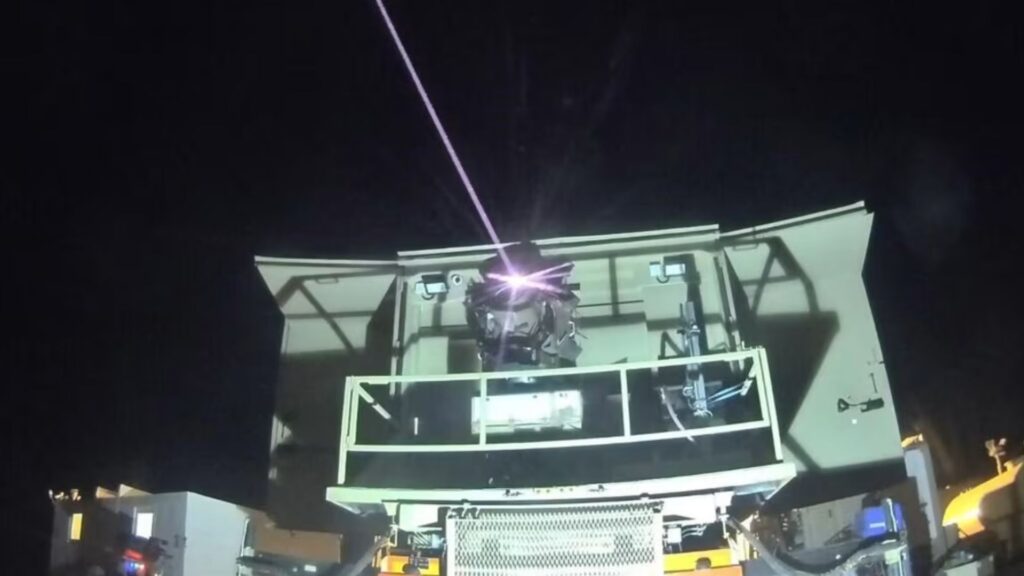
(Rafael Advanced Defense Systems) Iron Beam
Israel’s Defense Ministry announced Wednesday that it has successfully completed development and testing of the Iron Beam high-energy laser interceptor, marking a worldwide first in laser-based air defense. The 100-kilowatt system, jointly developed by Rafael Advanced Defense Systems and Elbit Systems, demonstrated exceptional performance during several weeks of live-fire trials in southern Israel, intercepting rockets, mortars, aircraft, and unmanned aerial vehicles with pinpoint precision.
Development and Testing Milestones
The Iron Beam program began as an experimental concept to complement Israel’s existing missile defenses—Iron Dome, David’s Sling, and Arrow—by providing a low-cost, high-speed interceptor for short-range threats. Over the past eighteen months, engineers at Rafael and Elbit refined the laser’s adaptive-optics array and beam-forming technology to ensure stable atmospheric propagation, even under desert heat and dust conditions.
Defense Ministry Director-General Amir Baram hailed the system’s operational maturity, stating, “This is the first time in the world that a high-power laser interception system has reached full operational capability” (Al-Monitor). Key achievements during testing included:
- Engagement of rockets and mortars at ranges up to 10 kilometers, with successful destruction within 2–3 seconds of beam contact
- Target acquisition and tracking using integrated electro-optical sensors, allowing rapid laser lock-on without radar assistance
- Multiple simultaneous engagements, demonstrating the system’s ability to defeat saturation attacks by focusing on high-priority threats first
Rafael Chairman Yuval Steinitz described Iron Beam as “a game-changing system with unprecedented impact on modern warfare,” crediting Rafael’s proprietary adaptive-optics modules that overcome atmospheric dispersion by dynamically adjusting lens curvature to maintain beam coherence over long distances.
Revolutionary Economics of Laser Interception
One of Iron Beam’s most compelling advantages is cost efficiency. Conventional Iron Dome interceptor missiles cost between $40,000 and $50,000 per shot, whereas Iron Beam’s per-shot operating cost is estimated at $2.50 to $10, covering only the electric power needed to fire the laser pulse (GV Wire). This dramatic reduction in cost addresses a critical weakness in missile defenses: the expense of intercepting low-cost rockets.
By integrating Iron Beam into the existing multi-layered defense architecture, the Israel Defense Forces (IDF) can conserve missile interceptors for higher-value targets—such as cruise missiles and ballistic rockets—while using the laser for swarms of cheap projectiles or unmanned drones. The virtually unlimited magazine depth, constrained only by available power, ensures sustained defense capabilities during prolonged engagements.
Combat-Proven Foundation and Future Deployments
Although Iron Beam’s full-power variant debuted this year, earlier prototypes proved combat-worthy. In May, Rafael revealed that scaled-down laser units successfully downed 40 Hezbollah drones during October 2024 operations in northern Israel—the first recorded combat employment of high-power laser interceptors. These early successes provided critical data on beam dwell times, target materials, and effective engagement doctrines.
With testing complete, the IDF plans to field the first Iron Beam batteries by year-end, integrating them at key sites in the south and north where rocket and drone threats are most prevalent. Defense Minister Israel Katz emphasized the strategic significance: “Iron Beam places the State of Israel at the forefront of global military technology and changes the threat equation with rapid, precise interception at marginal cost” (Times of Israel).
Elbit Systems CEO Bezhalel Machlis outlined the company’s broader laser family roadmap, which includes:
- Iron Beam-M, a mobile variant for ground units to protect forward forces from UAVs and mortar fire
- Lite Beam, a compact laser for integration on armored vehicles to defeat guided munitions at short range
- Airborne laser platforms, under development to intercept threats during cruise-missile attacks or airborne swarm operations
Strategic Imperative and Geopolitical Context
The accelerated deployment of Iron Beam reflects Israel’s response to evolving threats since the October 2023 Hamas onslaught, when rocket barrages tested Iron Dome’s interceptor inventory to its limits. The laser’s integration also aligns with global trends: the U.S. Army’s Directed Energy Maneuver Short-Range Air Defense (DE MSHORAD) initiative and the U.S. Navy’s Laser Weapon System (LaWS) program underscore a wider shift toward energy-based defenses.
International observers anticipate that Iron Beam’s success will spur other nations to fast-track directed-energy research. However, Israel’s head start—with operational readiness projected by December 2025—affords it unique tactical and technological leadership. As Iron Beam enters service, it promises to reshape air-defense paradigms by offering a cost-effective, responsive shield against a spectrum of aerial threats—from rudimentary rockets to sophisticated drones—solidifying Israel’s reputation as a pioneer in defense innovation.











